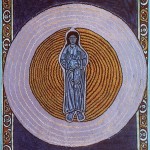You say there’s no supernatural God and that a supernatural being like Mary the mother of Christ doesn’t exist. Yet people have seen her. People have seen Christ. People have seen Krishna, Ram, Kali. Then there are all the angels and demons people claim have visited them. What is really going on with perceptions of supernatural beings? Are they real?
It is true that the histories of all the world’s religions and mystical traditions are filled with accounts of people’s encounters with non-embodied beings of many kinds. As you stated, angels, demons, deceased saints, Gods and gods—we differentiate because a God that influences millions in one era can become diminished into a god that has little or no impact at a later time—have been perceived by numerous mystics, and even by ordinary believers, although when people have such perceptions they are in states that are more mystical than ordinary. The question is asked, if we state no such beings exist, and yet many people have equally firmly stated they have seen them, then what is actually occurring?
In religious traditions, if someone sees a revered individual in spirit, that person is considered to be blessed, to have undergone a miraculous experience, and so to be special to the God that tradition worships. Is this all delusion? Yes. And no. The question demands a simple response, yet once again the psychology of what is involved is complex. In fact, what occurs during such perceptions is so complex there cannot be a single answer, or group of answers, that adequately accounts for what occurs. Ideally, each situation should be addressed case by case. Clearly, we are unable to do that here. So we will make the most of this opportunity and offer some general statements that we hope will clarify at least a little of what is involved. But before doing so we need to lay a foundation on which to construct our response.
HOW COME PEOPLE SEE JESUS KRISHNA AND ANGELS ON MEDITATION Photo Gallery
First, it must be understood that human beings are conditioned by their environment. Conditioning begins with the biological, in the sense that the majority of human beings are brought up in the belief that their identity is bound up in a body. This is true, but equally not true. It is not true because you are a spiritual identity who has chosen to inhabit a body for a period of time. Before, during and after inhabiting a body you continue to be a spiritual being who has an ongoing spiritual existence. So you are not bound into a body. Yet it is true that your identity is bound to a body in the sense that forgetting your spiritual identity is part of the deal when you are born human.
The way to reconcile these two apparently contradictory levels of identity is to say that the human you you are this time round is a sub-identity, a sub-personality, of your ongoing spiritual you. Your human sub-identity has been born and will die, whereas your spiritual identity continues, growing and evolving life by life, sub-personality by sub-personality, across human eons.
What is a human sub-personality? It is a psychological construct that results when your innate human traits interact with, and react against, social conditions and the personalities of those you grow up with. The way this occurs is complex. If you wish to explore all that is involved we direct you to the books Practical Spirituality and Psychological Spirituality. For our purpose here we will say that the personality of your human you contains specific talents and traits. Some you have inherited genetically, some you adopted from your parents and peers by copying them, and some you have brought into this life, having developed them in prior lives. Some of your talents and traits are positive, some are negative, some help you achieve your goals, and some work against what you want to achieve.
More simply, people can be said to contain shadow and light. No one is wholly shadow or wholly light, although some individuals certainly raditate more light and some radiate more shadow. In every life each individual has shadow issues they are dealing with. They also possess light that illuminates their existence and the lives of those they interact with. It has always been so with human existence, and will always be so.
So you as an identity have a body-focused identity and an associated personality driven by specific psychological traits. On top of both these levels of identity is placed a matrix of beliefs. Each individual views the world and interprets what it sees via this matrix. We use the word matrix because no one possesses a single set of beliefs. Everyone has multiple sets of beliefs laid over one another, criss-crossing to form layered patterns.
For example, beliefs about body dictate ideas of beauty and ugliness, which in turn generate admiration or distaste. A body shape that is considered attractive in one place is not so elsewhere. Skin colour has long been a factor in identity. Ideas around race, racial differences, racial superiority and inferiority, the practice of racial profiling, and judgements of whether another individual is a friend or foe, all use skin colour as a marker of identity. Biological markers have also long been used to generate social identity from which are derived notions of class and caste, higher and lower, worthy and unworthy, pure and tainted. The same points could be repeated in relation to sexual characteristics and orientation. Biased ideas grounded in biological and social identity have been sustained throughout human history and continue today.
Finally, there are the ideas people have about themselves and the world. These ideas are social, anti-social, economic, scientific, genetic, artistic, religious, metaphysical, psychological, philosophical, cosmological, neurological, numerological, biological, humanistic, linguistic, Darwinist, hubristic, war-seeking, peace-seeking … the list goes on. Innumerable ideas are available throughout the human domain that people adopt.
For many individuals, their most cherished ideas, the ideas that they consider define them as human beings, were socially conditioned into them during childhood. This is especially the case with religious beliefs and attitudes. Key ideas are also absorbed from peers during childhood and imbibed via education, whether it be state supplied education, or religious education, or an education obtained on the sly, involving notions deliberately adopted to contradict parental decrees or social norms. Related to this are the ideas consciously adopted and worked through during the teen period and adulthood, when individuals question the attitudes and beliefs in which they were raised.
Whether ideas are unconsciously absorbed during childhood or willingly adopted in adulthood, everyone perceives the world through a matrix of ideas. Some of these ideas are matters of belief, adopted because they feel right and not because they reflect the nature of reality. Other ideas have been thoroughly tested and found to be correct. Most people’s ideas fall between these two extremes. Whether tested or uncritically accepted, ideas may be true, be false, be ideas people want to be true, be ideas people suspect are false but think really what’s the difference?, or be ideas people go along with because it is to their advantage or simply because living is just easier that way.
Once again we have gone on a long disquisition before we are in a position to answer the question. However, this has been necessary because we need to establish a context in which to offer a response. The context is that it is always a particular human identity that perceives anything in the world. As we have been at pains to point out, this human identity is shaped by a range of biological, social and psychological factors, and perceives the world through a matrix of beliefs. So we are now in a position to address the question: When an individual perceives a saint, angel, demon or god, what is going on? Are they actually perceiving what they think they see? Or are they really perceiving nothing at all? Alternatively, are they perceiving something, but it is actually different from what they think they see?
The fact is that, depending on the individual involved and the circumstances of their perception, each of these three responses can apply. Sometimes people do perceive what they think they are seeing. Sometimes nothing is there. And sometimes they are projecting their own assumptions, hopes and fears onto an actually existing spiritual identity, seeing a god where there is only a presence, or perceiving a threat where actually friendly communication is intended. Much more rarely, they may be welcoming as friendly an identity they would be better off leaving alone. These latter responses come broadly under the category of projection and interpretation.
People project and interpret according to their assumed beliefs. Because standard human notions of identity are body-bound, when people think they see a spiritual being they see a particular bodily form because that is what they have been taught to expect. This kind of expectation applies when people see the Virgin Mary, Krishna, Christ or a saint. They perceive an actual spiritual presence, then project onto it the body image they have been conditioned to expect. In this case, a spiritual presence is perceived in a particular humanised form due to projected interpretation. All this assumes that spiritual identities really do exist to be perceived. This is certainly the case.
However, a second category of actual perception applies, because it is not just perceivers’ projections that lead to spiritual identities being seen as Krishna, Christ, Buddha, Kali, the Virgin Mary, or in the form of a saint. On occasion, a spiritual identity may deliberately adopt the guise of Krishna, Christ and so on. Why do so? Is trickery involved? Once again, yes and no. Yes, trickery is involved because in reality the spiritual identity does not exist in the form the perceiver sees. On the other hand, genuine communication does take place, motivated by a loving intent. The identity adopts that particular guise so the person may be comforted by a form they recognise. Familiarity reduces the fear that naturally rises in human beings when they meet something outside what is normal. This familiar form makes them more open to receiving what is being communicated. It may be an answer to a question, it may be guidance relative to a crucial life decision, or it may be to provide a boost at a time when the individual is feeling depressed or deflated. We repeat, a spiritual identity may adopt a familiar form in order to break down the barriers that normally exist between the spiritual and human domains.
A third category of perceptions occurs in the context of the cultural streams we mentioned earlier. Each religious and spiritual tradition has its own cultural stream containing characteristic rituals, formulas, imagery, metaphors, concepts and texts. Each stream also has individuals who have made a significant contribution during that tradition’s history. All this is useful to spiritual identities as they strive to communicate with human beings who are working within a particular tradition and whose beliefs are defined by it. In effect, the cultural stream provides a language and ready-made symbols and concepts to facilitate communication. Enquiring believers who are given insights by helpful spiritual identities receive them via familiar religious symbols, through symbolic dreams, and via visions in which a significant historical figure is perceived. Those who have these kinds of perceptions are often so impressed by them that they conclude their tradition’s symbols and historical figures are deep truths. For the spiritual identity who provides the insights, the same religious symbols and figures are merely artefacts of that tradition’s cultural stream, conveniently at hand to facilitate communication.
Everyone needs language to talk to another. Cultural streams provide the required language. However, cultural streams have a downside. Over time, baggage builds up within each stream. When those who receive insights from the spiritual domain use their cultural stream to interpret their experiences, their interpretation is tainted by baggage. As a result they alter what is communicated to them, sometimes to a great degree. So while on the one hand the artefacts present within cultural streams can facilitate communication due to both sides sharing an understanding of what those ideas, symbols and metaphors mean, on the other hand cultural baggage can lead to the misinterpretation of what has been communicated.
B y baggage we refer to various human-created ideas regarding what the spiritual domain consists of, how people should think and behave in the human domain, and how the two domains are related. As a religious tradition ages, it accumulates more and more baggage, which believers adopt. This makes the tradition’s cultural stream less and less effective for sustaining direct and unadulterated communication between the spiritual and human domains.
To conclude, spiritual identities exist and are perceived, but human beings have a tendency either to accept such perceptions at face value, or to reject them as unlikely or impossible. The current clashes in public forums between believers and unbelievers, between the curious and the sceptical, as well as the conflicts that occur within individuals as they struggle to process perceptions outside the range of what is normal, reflect the extent to which confusion exists around perceptions of spiritual identities. This is because there is little acknowledgement of the degree to which individuals affect what they perceive. We repeat, all debates about whether or not spiritual identities exist externally to the observing individual, and regarding the true nature of such identities, need to recognise the degree to which such perceptions are impacted by internal processing.


















